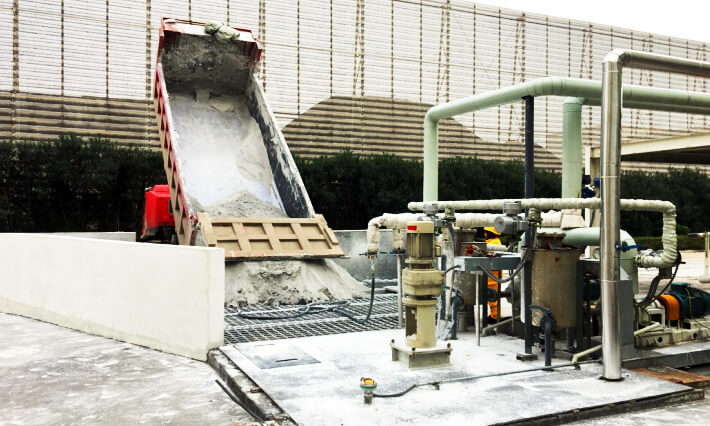
Paper making is a core industry for Gucheng township of Zhumadian city, Henan province, and white mud is a type of waste produced during the paper-making process which mainly contains calcium carbonate, with greyish white and no strange smell. If part or all of the white mud is discharged, it will cause serious pollution to the environment, but even if stored in piles, it will also produce dust and leak alkaline corrosive liquid, still polluting the environment to a great degree. Due to “ten policies regarding soil” and “ten policies regarding water”, landfills were reluctant to accept white mud from paper mills, causing hundreds of thousands tons of white mud to pile in several paper mills. In addition, new white mud is produced every day. When it was windy or raining, residents in surrounding areas often lodged complaints against such paper mills which were then strictly monitored by relevant environmental protection departments and asked to deal with the situation. Careless storage of white mud would cause pollution and lead to punishment on the paper manufacturers. White mud then became a serious issue of such factories.
In July 2015, Henan China Resources Power Gucheng Power Plant learned about the environmental issues from the solid waste of white mud produced by paper mills during market research. At the time, desulphuriser - limestone powder, the bulk consumable material was getting more and more expensive year by year as more environmental protection measures were taken, becoming an area that took up a large part of the Company’s expenses every year. If white mud could replace limestone powder as a desulphuriser, it would not only greatly reduce the purchase of limestone powder but also completely solve the issue of secondary pollution caused by storage of white mud in paper mills.
Thus, Gucheng Power Plant set up a project team to look into the issues involved in using white mud as a desulphuriser. The first challenge faced by the team was that there was no industry standard in the field and no successful case to learn from. What issues would emerge when using white mud as a desulphuriser for the power plant was unpredictable. Following research by many parties, it was understood that a power plant in Southern China once tested the project for a short term but eventually abandoned the project. However, that power plant would not give more information on why they gave up. They only advised against trying. The team did not give up. In August 2015, following repetitive testing data and technical analysis, the team came up with testing schemes and began to try to mix in a small amount of white mud to replace limestone powder. Close inspection showed that environmental protection data did not change and the system operated as normal. The team then increased the amount of white mud mixed in and continued to adjust various parameters regarding system operation, solving the problems occurred in the process in a timely manner. During the mixing process, chlorine ion data was once detected as abnormal and slightly high. The team then stopped the experiment, analyzed relevant data, looked for reasons, communicated with paper mills to adjust the amount of water used when white mud was being produced to reduce the content of chlorine ion. Following nearly half a year’s experiment and exploration, issues were being discovered and then solved, and the amount of white mud mixed in to replace limestone powder continued to increase.
Data showed that desulphurising discharge indices, slurry quality and dehydration system operation were all normal. Desulphurising gypsum quality did not change. During the experiment, paper mills attached great importance to the project and showed great cooperation. Their main leaders visited the power plant with a team multiple times to learn about the progress and showed great excitement when the experiment succeeded eventually. They also expressed sincere gratitude to Gucheng Power Plant for solving their worries post production.
To meet the demand from the extensive use of white mud, Gucheng Power Plant carried out careful analysis and set up standards in March 2016 according to previous testing results. The scheme was changed completely three times before the original limestone slurry manufacturing equipment system was eventually negated and a white mud operation system was designed according to Gucheng Power Plant’s own characteristics. The project began its foundation digging in May, was completed in June and was put into use in July. In 2016, 5,182.96 tons of white mud was mixed in, saving RMB 860,000 in limestone powder cost. In 2017, 22,014.74 tons of white mud was mixed in, saving RMB 1.6 million in limestone powder cost. Since 2017, Henan province increased efforts in treating air pollution, subsequently closing off some mines and leading to short supply in limestone powder. When surrounding power plants were impacted, Gucheng Power Plant remained unaffected because it used white mud. The success in using white mud as a desulphuriser not only brought economic and social benefits to Gucheng Power Plant but also provided a solution to the treatment of white mud produced in the paper making industry in China.
In 2017, a large number of media platforms including the official website of Henan People’s Government, Henan Daily and www.dahe.cn released an article introducing what Gucheng Power Plant did to fulfil its social responsibilities and the effects, and recognised that Gucheng Power Plant set an example as an “Energy Saving Efficiency, Green Environmental Protection” company. In recent years, Gucheng Power Plant conquered technical issues in production and as of now it has been granted 16 patents by the government.
